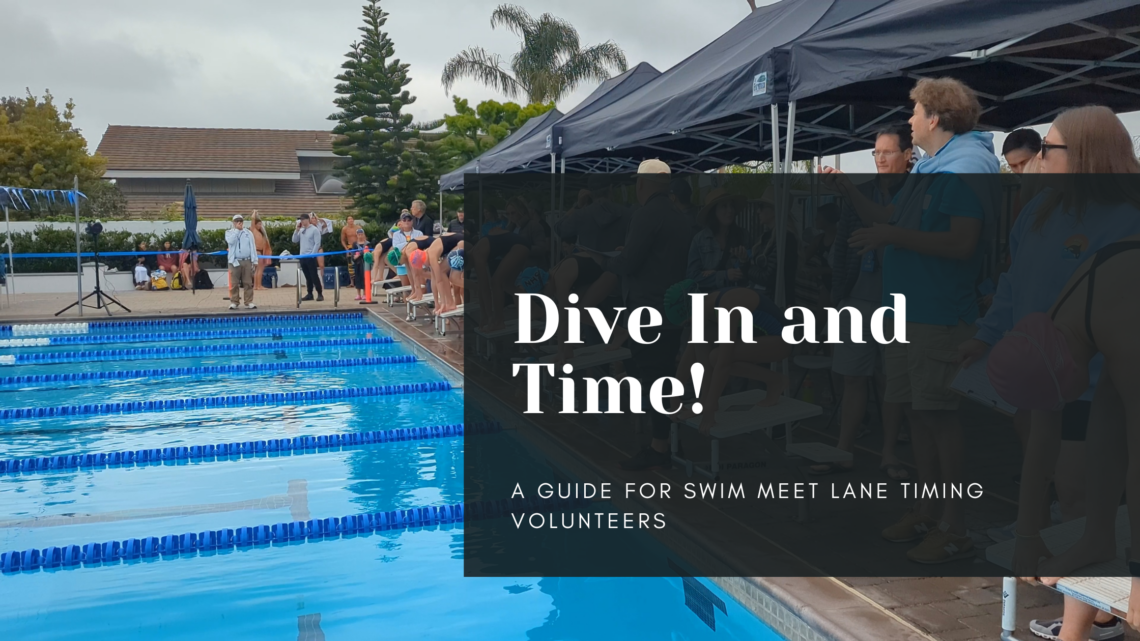Volunteering as a lane timer at a swim meet? Awesome—you’re helping make the meet happen, and giving swimmers the chance to race their best. Timing might seem intimidating at first, but once you understand the process and your role, it’s actually pretty straightforward (and even fun!).
Here’s a quick guide to understanding the three types of finish times—pad, pickle, and watch—plus the roles of Chair 1 and Chair 2 timers.
🧭 Pad, Pickle, and Watch: What Do They All Mean?
Each swimmer’s finish time can be recorded three ways:
- Pad Time (Primary, but smaller meets/teams may not have these)
- Pickle Time (Backup)
- Watch Time (Manual Backup)
Let’s break these down.
🧱 1. Pad Time – The Main Event
When a swimmer touches the wall at the end of their race, they’re supposed to hit a touchpad. This pad sends a signal to the Timing System Computer and records the swimmer’s finish time. In most cases, this is the official time used.
But… swimmers don’t always hit the pad hard enough or they miss it altogether—touching above it or glancing off the edge. That’s why we need backups.
🥒 2. Pickle Time – The Button Backup
There are two funny black wires hanging down from the canopies or each lane on the start end of the pool – these are called pickles. Lane timers stand ready with a pickle button—a handheld button connected to the Timing System.
When the swimmer finishes the race and makes their final touch, each timer presses the pickle. This sends a backup time to the computer in case the pad didn’t register.
Pro tip: Press the pickle once and only once at the exact moment of the swimmer’s final touch.
⌚ 3. Watch Time – The Manual Safety Net
One timer in the lane will also use a stopwatch to manually time the race from start to finish.
Here’s how this works:
- Start the stopwatch on the starting signal.
- Stop it the moment the swimmer touches the wall at the end.
- The second timer (usually your partner) writes the time down on a timer sheet.
This is our old-school safety net, used only if both the pad and pickle times fail or are inconsistent.
🚨 What If the Stopwatch Fails?
Mistakes happen! If the Watch Timer (Chair 2) starts the stopwatch late or accidentally stops it before the swimmer finishes:
- Raise your hand immediately and call out:
"WATCH ON LANE 3!"(or whatever lane you’re in) - The Head Timer will come to your lane with a spare stopwatch—good news: they always start two watches just in case this happens.
- You’ll receive the backup watch to continue timing for the remainder of the race.
No stress—this is common, and there’s a system in place to handle it.
🏊 What is a Lane Timer?
Lane timers are responsible for recording the time it takes each swimmer to complete their race. Each lane typically has two to ensure accuracy. While electronic timing systems are often used, manual timing is a critical backup and sometimes the primary method, especially at smaller meets.
Who Does What? Chair 1 vs. Chair 2
Each lane typically has two timers, and each has a specific job:
- Chair 1 – The Recorder
- Holding the clipboard
- Recording the watch time on the timer sheet
- Pressing the pickle button at the swimmer’s finish
- Calls out the swimmer’s name off the sheet for the next heat so they are ready to go before the next race starts
- Chair 2 – The Stopwatch Operator
- Starts the stopwatch at the start signal
- Stops the watch when the swimmer touches the wall
- Reads the time out loud to Chair 1 for recording
Both timers press the pickle button, so there are two backup signals sent for added accuracy.
⏱️ What You’ll Be Doing
- At the start signal (a beep or the strobe flash), Chair 2 starts the stopwatch.
- Both timers carefully watch the swimmer approach the wall.
- At the finish, both timers press their pickle buttons.
- Chair 2 stops the stopwatch and calls out the time.
- Chair 1 records the watch time on the sheet.
- Chair 2 resets the stopwatch for the next race.
🧼 Pro Tips for Smooth Timing
- Stay focused—you only have a few seconds to react.
- Be consistent—press the pickle and stop the watch at the swimmer’s first touch on the wall.
- Double-check entries on the sheet—neat and accurate is the goal.
- Ask for help if you’re unsure—meet officials and other timers are happy to help.
- Stay until your shift is over or until a replacement arrives. It’s a team effort.
🥇 Final Thoughts
Being a lane timer is simple but essential. Timing isn’t just a technical job—it’s about fairness. Swimmers train hard for these races, and they deserve a finish time that reflects their effort. Whether the pad works or not, your timing helps ensure every swimmer gets credit for their race.
Have any tips or timer stories to share? Drop them in the comments below!






